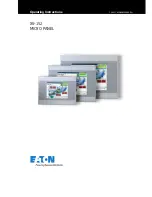
I.B. 48020
Page 3
Effective 4/00
LATCH REMOVAL
1.
Remove latch control wires from terminals 7 & 8 on
contactor coil control board.
2.
Remove the four 8mm x 1.25 bolts from the underside
of the base plate that secure the latch assembly to
the base plate.
3.
Remove the two 6mm x 1.0 bolts from the front of the
contactor that secure the roller bracket assembly to
the armature plate.
COIL CHECKOUT AND REPLACEMENT
If the contactor fails to open when the unlatch coil is
energized, the coil may be faulty. To determine if the coil
has the proper resistance, connect an ohmmeter across
the coil leads where they are connected to the bridge
rectifier. Refer to table I for the correct impedance for the
different voltage coils.
TABLE I: UNLATCH COIL IMPEDANCE
Coil Volts
Impedance
24
0.77 – 0.95
48
2.95 – 3.55
110/120/125
10.97 – 11.19
220/240
44.57 – 54.57
If the coil impedance is not within the ranges in table I, it
must be replaced. Follow the steps below for replace-
ment.
1.
Remove latch control wires from terminals 7 & 8 on
contactor coil control board.
2.
Remove the four 8mm x 1.25 bolts from the underside
of the base plate that secure the latch assembly to
the base plate.
3.
Remove latch coil core retaining bolt (8mm x 1.25),
Figure 6, and remove all components secured by this
bolt.
4.
Remove the 4mm x .7 screw securing full bridge diode
to latch coil bracket.
5.
Remove old coil from core.
6.
Insert coil core into new coil, insuring rubber gasket is
between core and coil bobbin.
7.
Install 4mm x .7 screw securing diode to latch coil
bracket and tighten to 9 lb-in. Do not over tighten,
cracking of diode housing could result.
8.
Reassemble all components removed in step 3,
insuring steel shim is between coil core and coil core
bracket, and secure 8mm x 1.25 bolt to latch base
plate. Insure all components are correctly aligned and
the coil wires are not binding or pinched, Figure 7.
9.
Reinstall latch assembly and adjust as described in
steps 3 to 8 in section on Installation.
Figure 5: Set gap between roller bearing and cam to .5mm
(.020 in.)
Figure 6: Coil core retaining bolt
Latch
Release
Tab






















